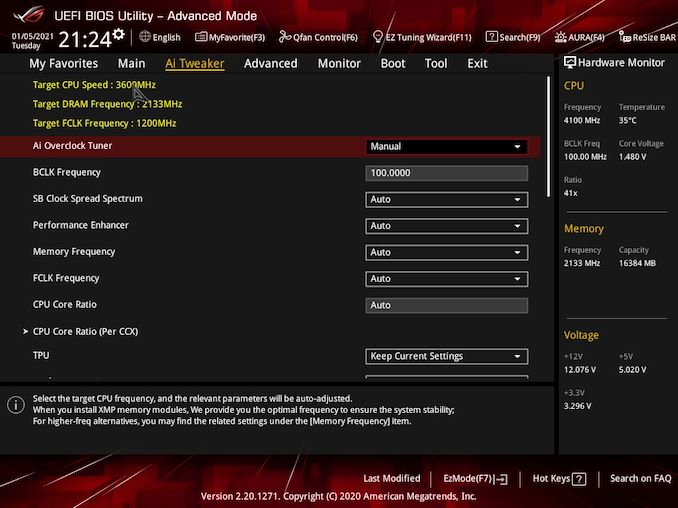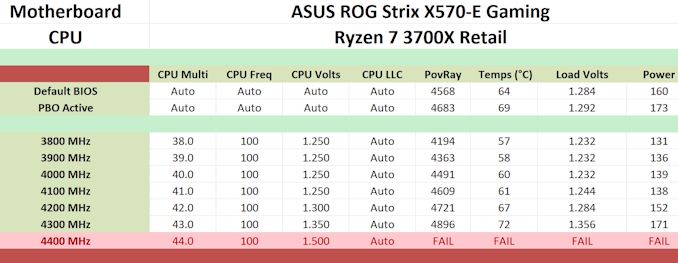The ASUS ROG Strix X570-E Gaming Motherboard Review
by Gavin Bonshor on January 25, 2021 11:00 AM EST- Posted in
- Motherboards
- AMD
- Asus
- ROG
- AM4
- Ryzen 3000
- X570
- Strix X570-E
- Ryzen 5000
- X570-E Gaming
Overclocking Ryzen 3000
Experience with the ASUS ROG Strix X570-E Gaming
Despite AMD's Ryzen 5000's presence on the current market and with support for these across various AM4 chipsets, we do all of our AM4 testing with the Ryzen 7 3700X processor for consistency. Overclocking can yield many benefits in performance, but at the drawback of extra heat and power. This is a consequence of adding more CPU VCore.
Most power delivery is over-engineered to support the latest processors, however hot they run. This is a continuance of CPU vendors constantly pushing default and turbo clocks, pushing the silicon to its limits. Anyone looking to overclock will need to consider more aggressive cooling types such as large premium AIOs.
Using the ASUS ROG Strix X570-E Gaming for overclocking, the firmware itself is user-friendly and benefits from a consistent design throughout. All of the board's overclocking settings can be found in the Ai Tweaker section of the Advanced mode, which can be accessed by pressing the F7 key. Overclocking the CPU is easy to do which can be done as easily as altering the CPU Core Ration and CPU VCore voltage. For more in-depth overclocking and tweaking, ASUS includes base clock (BCLK) control which not only overclocks the CPU but the memory too.
Touching on memory overclocking, ASUS includes a wide variety of customizable memory latencies for fine-tuning. Users can enable X.M.P 2.0 profiles on memory with built-in profiles, although ASUS for its AMD models calls this D.O.C.P or Direct Over Clock Profile. This is just ASUS's fancy way of saying X.M.P. AMD recommends a maximum FCLK (Infinity Fabric Clock) of 1800 MHz, which ties in with what DDR4-3600 memory in a 2:1 ratio. This is AMD's recommended sweet spot for the best memory performance.
Overclocking Methodology
Our standard overclocking methodology is as follows. We select the automatic overclock options and test for stability with POV-Ray and OCCT to simulate high-end workloads. These stability tests aim to catch any immediate causes for memory or CPU errors.
For manual overclocks, based on the information gathered from the previous testing, start off at a nominal voltage and CPU multiplier, and the multiplier is increased until the stability tests are failed. The CPU voltage is increased gradually until the stability tests are passed. The process is repeated until the motherboard reduces the multiplier automatically (due to safety protocol) or the CPU temperature reaches a stupidly high level (105ºC+). Our testbed is not in a case, which should push overclocks higher with fresher (cooler) air.
We overclock with the Ryzen 7 3700X for consistency with our previous overclocking tests.
Overclocking Results
The ASUS ROG Strix X570-E Gaming performs very competitively against some of the best AM4 boards we have tested. At default settings, the board is using conservative CPU VCore levels at full load, with slightly higher CPU VCore with PBO active. Despite including an enabled mode, the default profile does include elements of PBO with little operating both profiles in POV-Ray performance.
In our manual testing in increments of 100 MHz from 3.8 to 4.3 GHz, we saw an increase in POV-Ray performance throughout our testing. Along with the increase in CPU VCore from 4.1 to 4.2 and beyond, this brought extra temperatures and power, but not enough to cause too much of a negative effect.
The VDroop control when using the default load-line calibration settings is also tight, with the CPU VCore under volting throughout the majority of our testing, with slight overcompensation when testing at 4.3 GHz. Overall the ASUS ROG Strix X570-E Gaming is a capable performance in our overclock testing.












46 Comments
View All Comments
vanish1 - Monday, January 25, 2021 - link
Its the style that Asus uses now. My old P6X58D-E were different in their actuation and it wasnt even an afterthought releasing themTrapStoner - Monday, January 25, 2021 - link
Your old x58? Lmao this is not 2008 no more, every board nowadays uses the same style locks. I have this board too and i can say that yes they are a bit annoying, but my asrock z97 board was absolutely the same so you just get used to it.vanish1 - Monday, January 25, 2021 - link
yeah no shit its not 2008 anymore captain obvious, the point is if it aint broke dont fix it.putins_pinky - Thursday, January 28, 2021 - link
Looks like the heatsinks are in the way. My Prime X570-P has the same slot design and it's no problem.docofkult - Monday, January 25, 2021 - link
I assume that Asus did not name the board x570 and then go for the B550 chipset. Check the specs overview ;)Slash3 - Monday, January 25, 2021 - link
I liked the "thicker thins" on the VRM heatsink block.:P
Makaveli - Monday, January 25, 2021 - link
"Some of its main features include Intel 2.5 GbE and Wi-Fi 6, with dual PCIe 4.0 x4 M.2, with plenty of USB 3.2 G2 connectivity."This board has Realtek 2.5 GbE not intel.
Jpeterson1 - Monday, January 25, 2021 - link
It has both intel gigabyte, and realtek 2.5 gigabyte Ethernet. Just take a look at the back panel.Makaveli - Monday, January 25, 2021 - link
I can see that on the back panel. However what I quoted doesn't imply that.MTEK - Monday, January 25, 2021 - link
Nice board. I wanted to buy it in November along with an 5950X. However, the lack of availability and the China tariffs has been a mood killer. If the situation doesn't remedy itself by the end of Q2, I'll probably wait for this board's successor and Zen 4. Or rethink this expensive hobby.